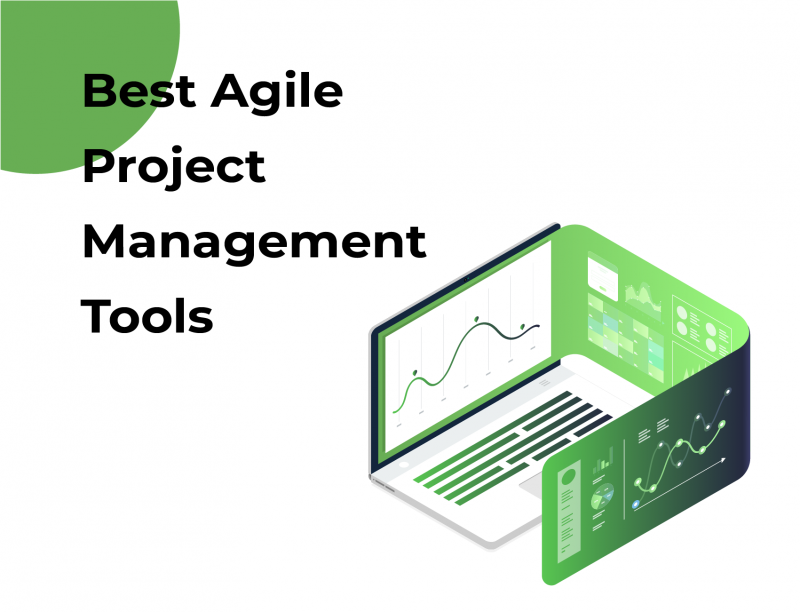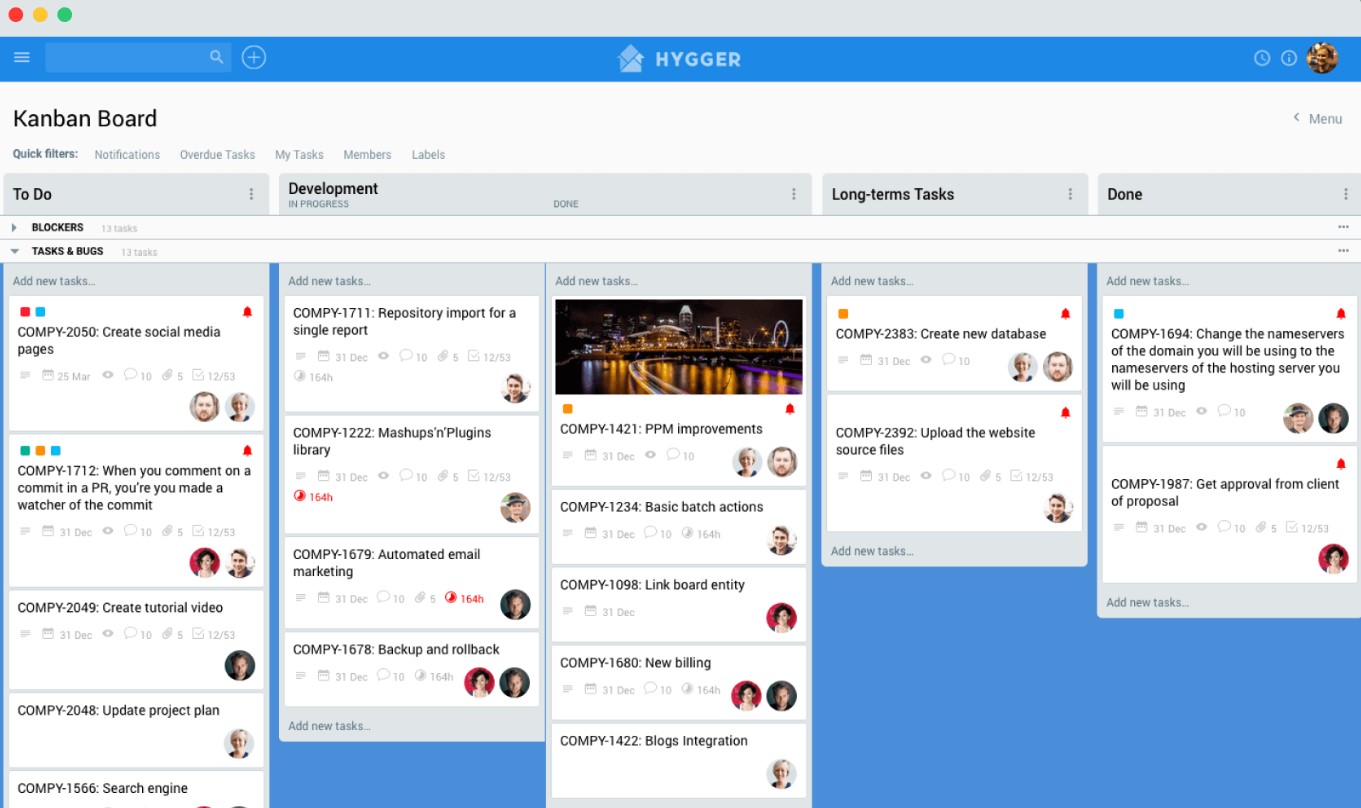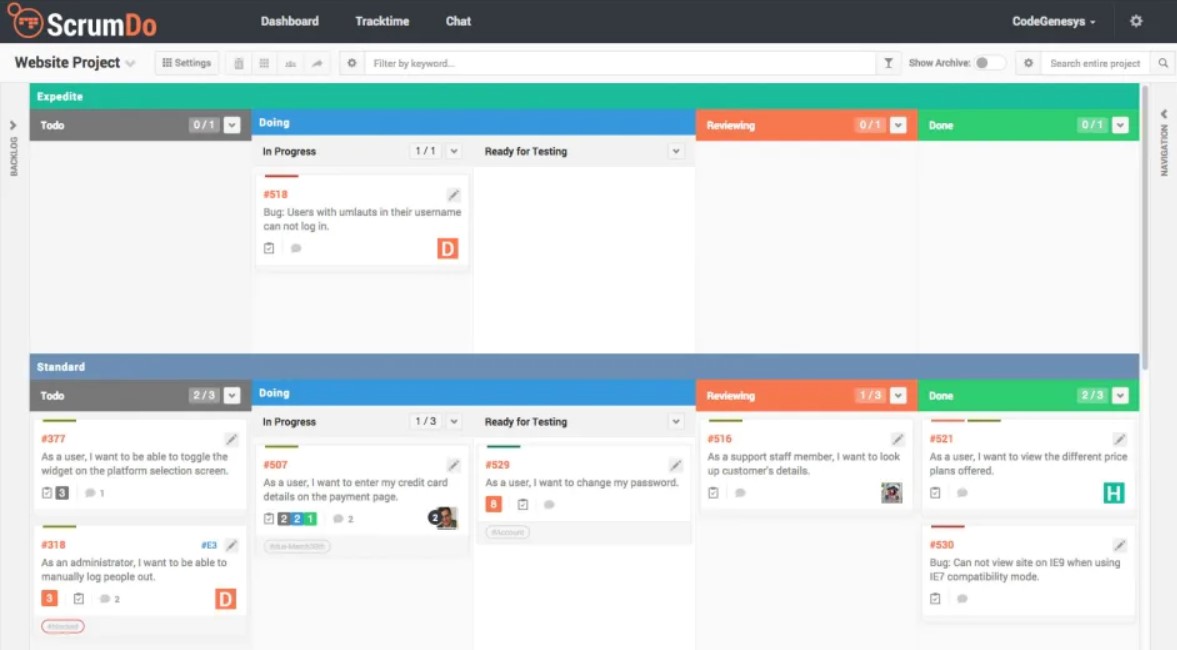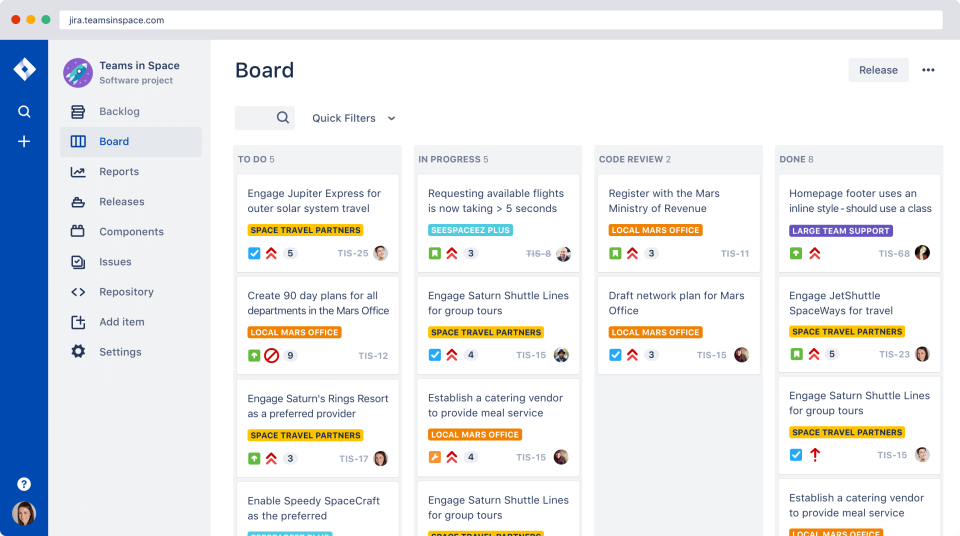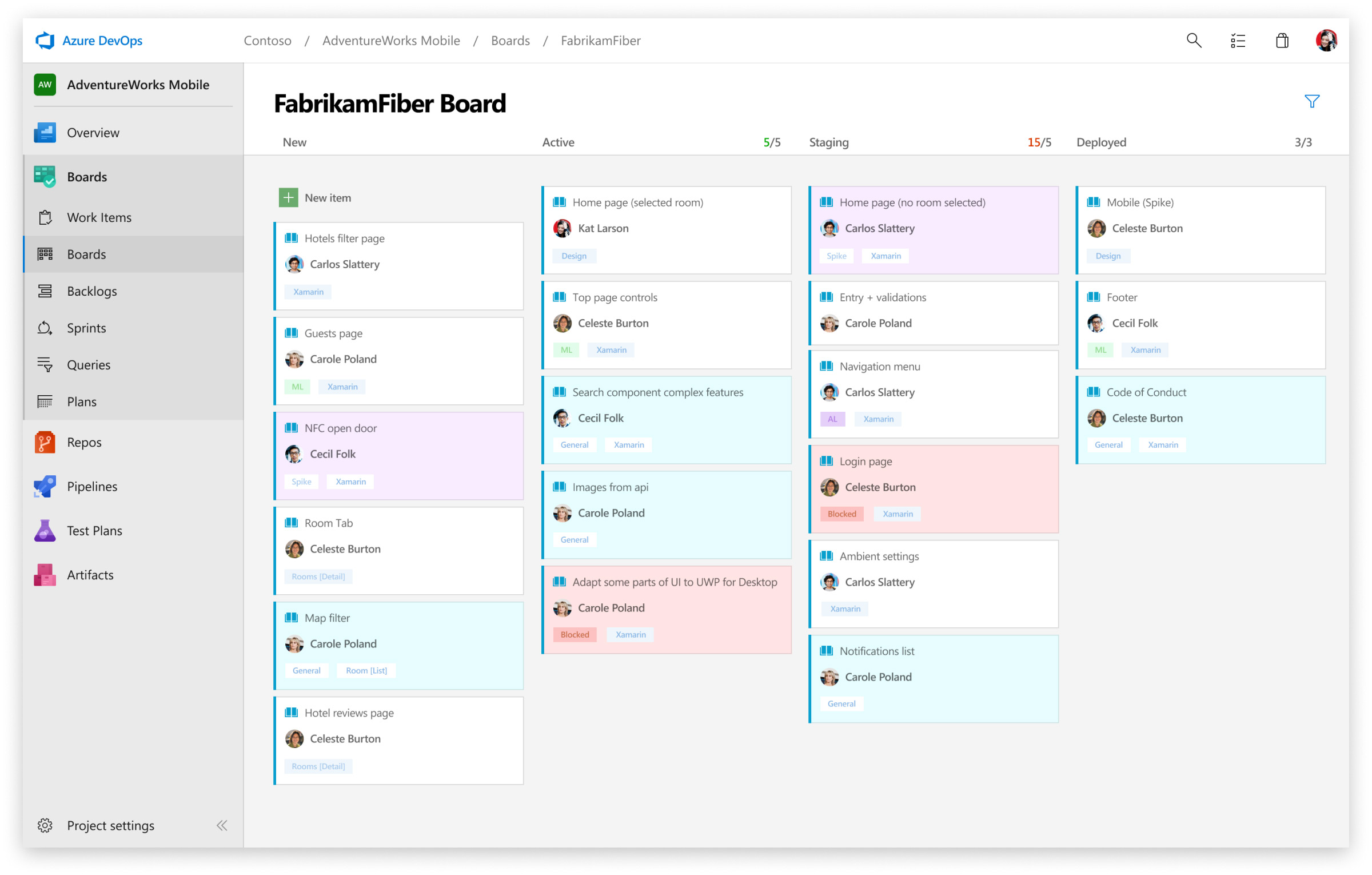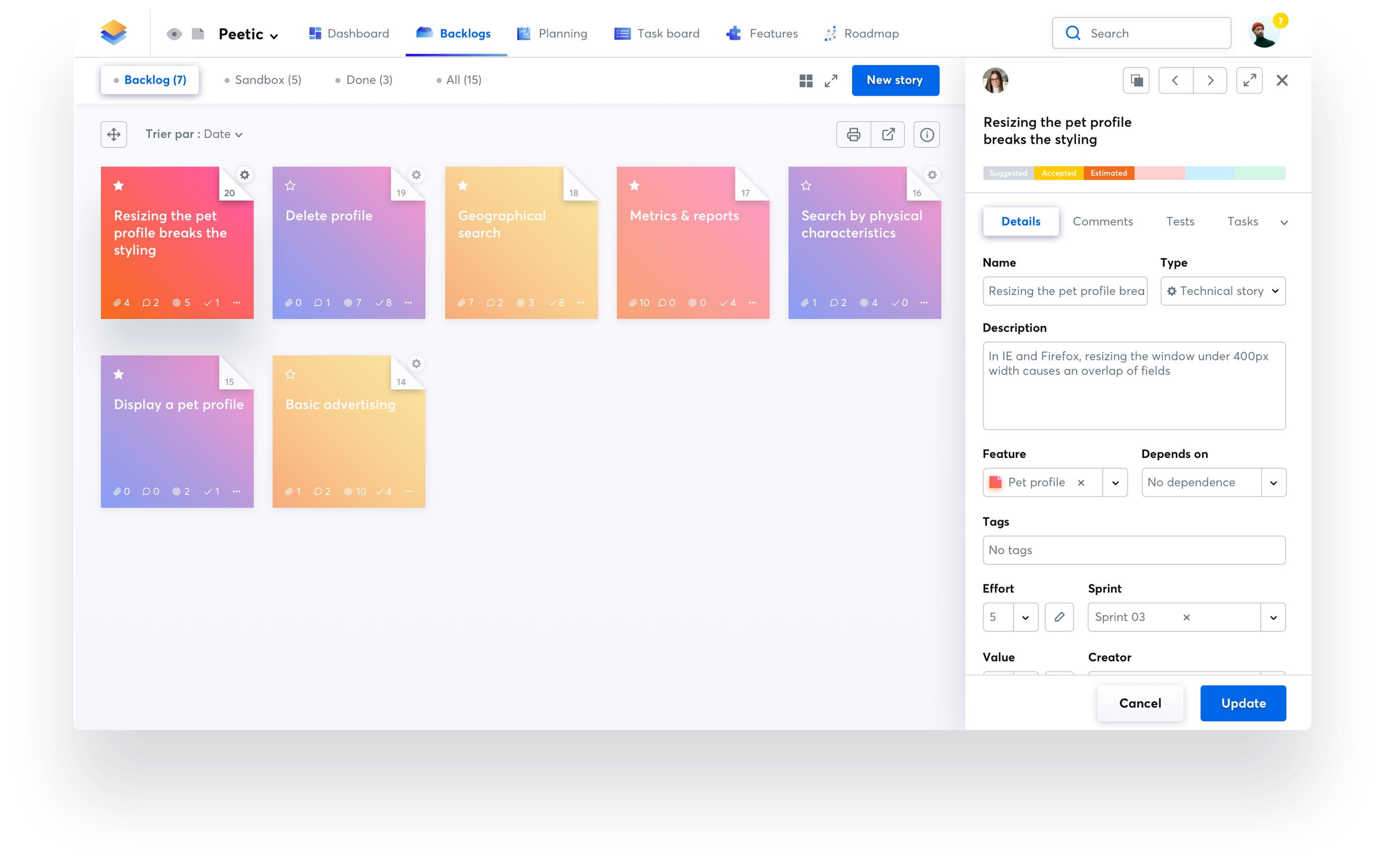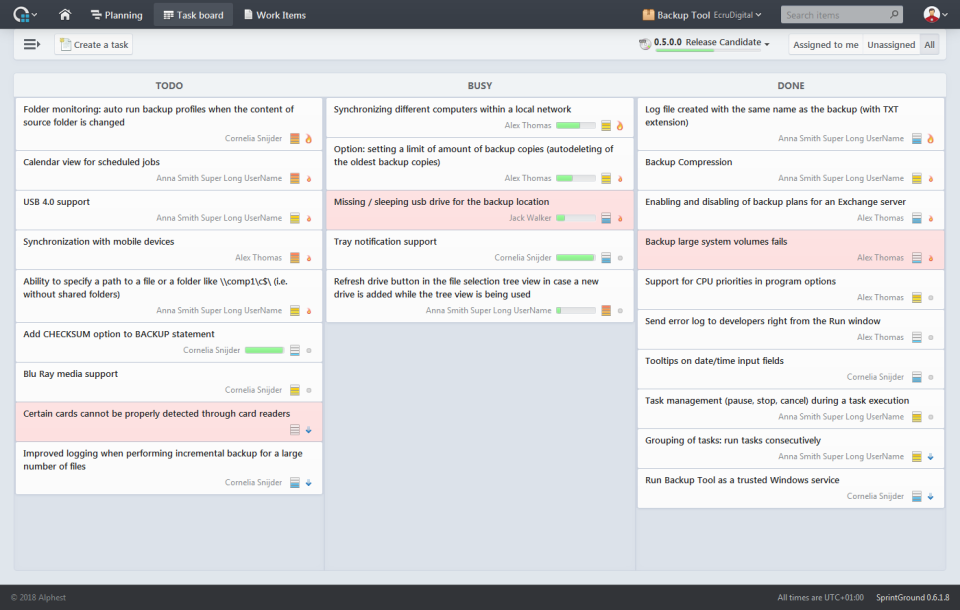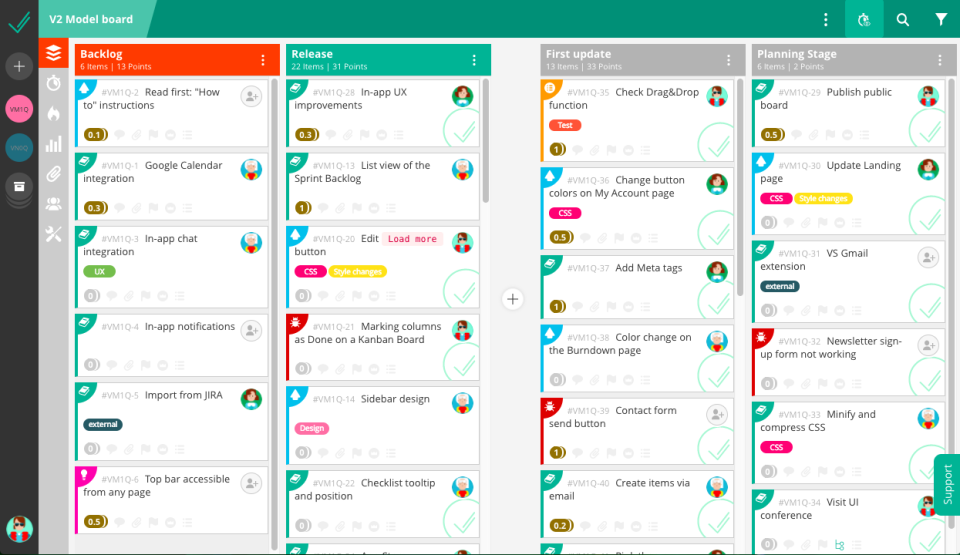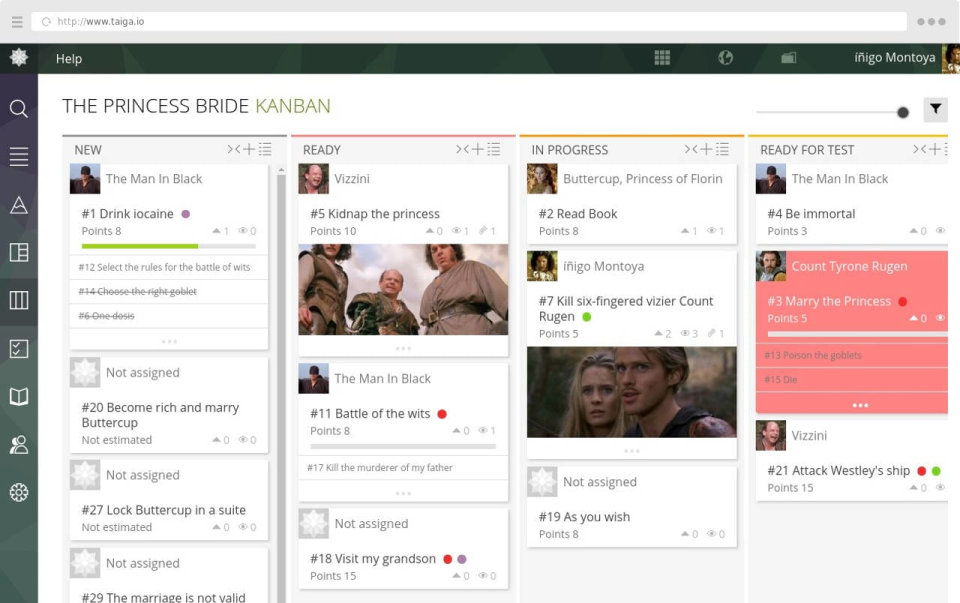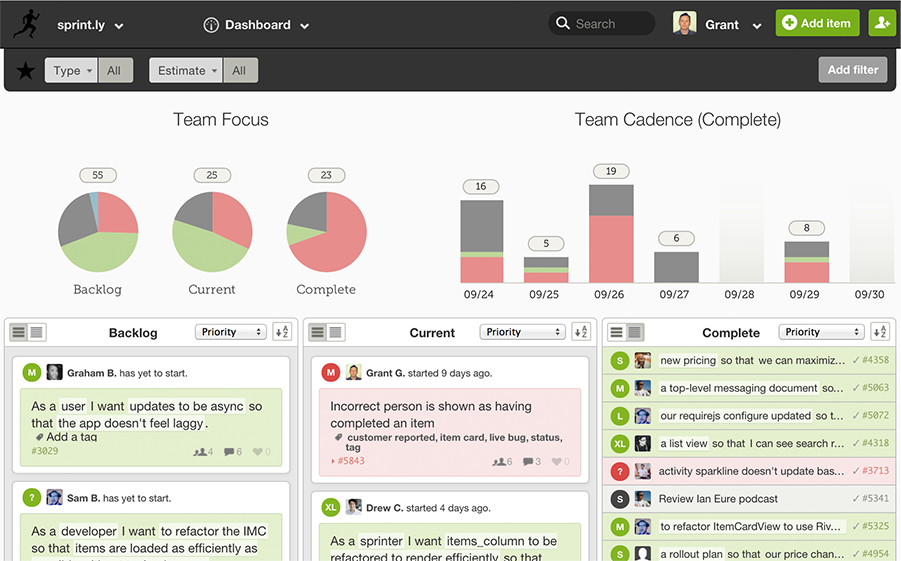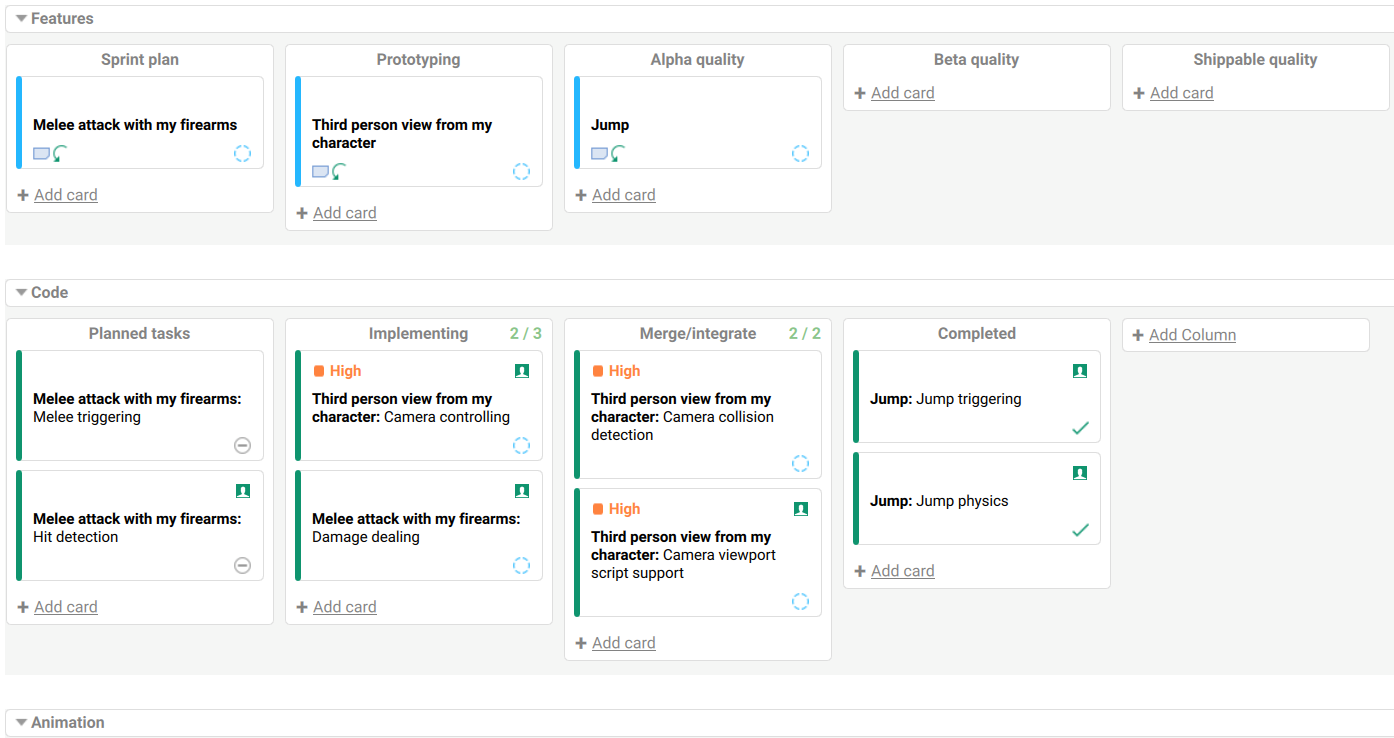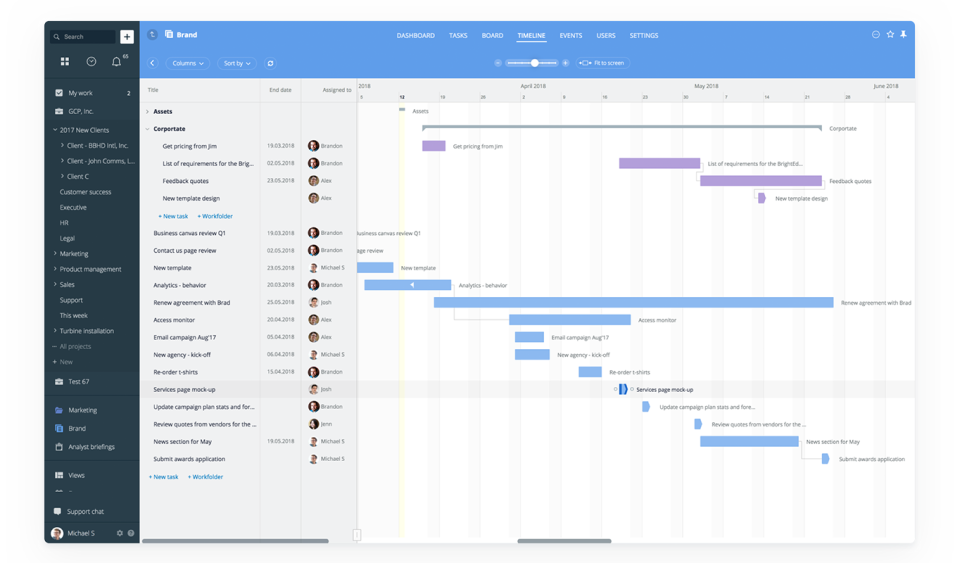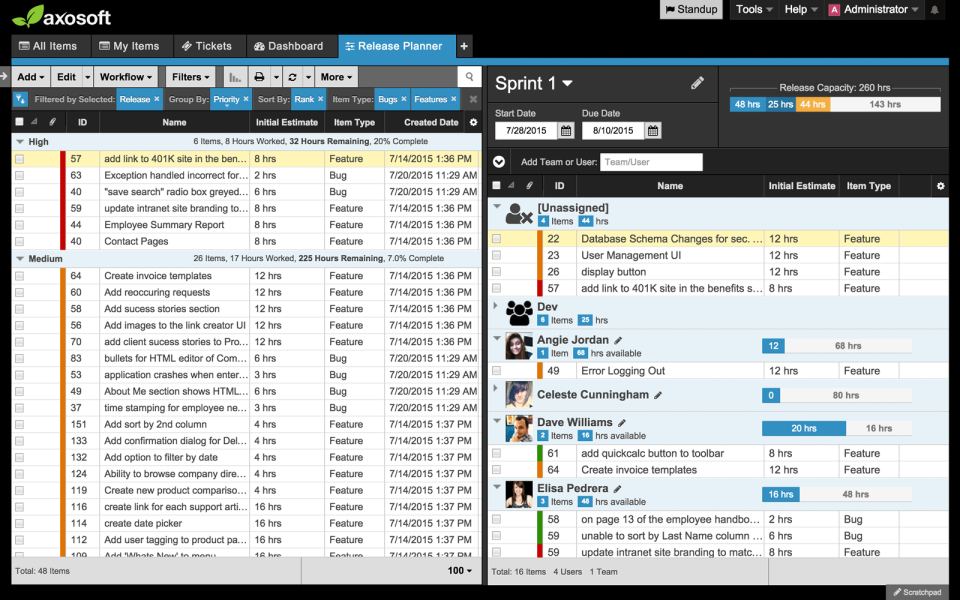Agile is a popular word in project management today. In this guide, we will try to explain what stands behind this popular concept, how Agile tools can help your particular project, and, what is more important, how to choose the software right for you. If you are in a hurry, scroll down to our Agile tools comparison and quickly check the features and prices of the most promising software. If you have a few mins, let’s explore first the nature of Agile.
Contents
Agile methodology basics
Agile is a project management concept that originated to support projects with many unknowns. Agile allows project managers to deliver and market projects in a flexible way and handle changes faster and easier than other project methodologies. The diversity of Agile approaches, such as Scrum and Kanban, made it possible to take a new look at project management.
The Agile methodology rests on 4 key ideas and 12 principles, which we will now cover briefly.
The 4 key pillars of Agile are documented in the Agile Manifesto book and say that:
- Individuals and interactions are always over processes and tools.
- Working software is more important than comprehensive documentation.
- Customer collaboration is superior to contract negotiation.
- Reaction to changes is more crucial than following a plan.
Agile project management is based on an iterative approach. This means that project planning and execution happens in sprints. And on every stage, the team presents project deliverables to the customer and then adapts the plan and the scope of work. The customer is closely involved in the process, reviews the progress, and provides feedback.
All projects that follow the Agile development methodology should focus on 12 core principles that are stated in the Manifesto for Agile Software Development.
12 Agile principles
- Our highest priority is to satisfy the customer through early and continuous delivery of valuable software. The first principle is about bringing a valuable product to the customer on every iteration rather than keeping the customer blind till the very end of development.
- Welcome changing requirements, even late in development. Agile processes harness change for the customer’s competitive advantage. However difficult it is to accommodate change, Agile welcomes even last-minute improvements as they make the final product more competitive. This principle makes Agile more beneficial for customers than other development approaches.
- Deliver working software frequently, from a couple of weeks to a couple of months, with preference for the shorter timescale. Iterations of Agile projects usually last for one to four weeks. Such short sprints let the team introduce the needed changes faster.
- Business people and developers must work together daily throughout the project. According to the fourth principle, regular communication between the development team and stakeholders is crucial. The dialog usually happens as a daily meeting.
- Build projects around motivated individuals. Give them the environment and support they need, and trust them to get the job done. Agile is about putting the right people in the right places and giving the team autonomy instead of micromanaging them. The project manager focuses on capabilities, motivation, and support to achieve results.
- The most efficient and effective method of conveying information to and within a development team is face-to-face conversation. Face-to-face communication or at least video conferencing is considered more effective than email or phone.
- Working software is the primary measure of progress. Agile is about real results, so the time spent and project documentation are secondary to the efficiency of final deliverables.
- Agile processes promote sustainable development. The sponsors, developers, and users should be able to maintain a constant pace indefinitely. Agile proclaims that project interactions should be timed equally, and there should be no need for overtime work.
- Continuous attention to technical excellence and good design enhances agility. Agile is about making the product better and more efficient by introducing innovation with every iteration.
- Simplicity – the art of maximizing the amount of work not done – is essential. Agile focuses on doing precisely the needed and valuable things and avoiding unnecessary documentation, steps, and processes. Achieving the goals stated in the project specification is of utmost importance for the team.
- The best architectures, requirements, and designs emerge from self-organizing teams. The Agile methodology says that the team brings the best results if it is motivated to work and given enough autonomy. Team members collaborate and innovate freely, which leads to max efficiency.
- At regular intervals, the team reflects on how to become more effective, then tunes and adjusts its behavior accordingly. For sure, no team is ideal, so Agile team members should have regular performance reviews to improve their skills and processes, and grow.
The advantages of adopting the Agile methodology for project management can be summarized in the following list:
- Close interaction with the customer
- More adaptivity
- Quicker release
- Ferer risks
- Continuous innovation
As a project management methodology, Agile is often compared to Waterfall, which is much more rigid and requires a preceding gathering of requirements and consecutive planned actions. The choice between the two depends on how well you know the requirements upfront and how many changes are possible in the course of the project.
You can learn more about Agile in this post — and now let’s go straight to Agile tools.
What are Agile tools?
Agile project management software includes all solutions that can be used to adopt Agile methodologies while developing products or providing services. Such tools should support iterative workflows and feedback management, as this allows the Agile team to continuously enhance the product.
Agile development tools make project management more efficient, as the team gets:
- a centralized database for storing all project data,
- a single collaborative workspace for discussing all the details,
- project progress tracking functionality for keeping everyone on the same page and
- performance measurement.
Agile project management tools should have specific features for Agile frameworks, such as Scrum, Kanban, Extreme Programming (XP), and Adaptive Project Framework (APF).
What are the benefits of Agile project management tools?
Working with Agile project management software gives the development team a range of advantages.
- Quality product. Agile tools allow teams to visualize all tasks and plan the project activity — including changes — more thoroughly. As a result, stakeholders and clients review each step on time, and the team can introduce tweaks and deliver a more quality product.
- More customer engagement. Using Agile project management tools and methodology, the team can work in sprints, and the project manager can engage with the client in the course of the project. This way, the project becomes transparent for customers.
- Maximum efficiency. The methodology itself and Agile development tools are about effective time management and minimizing rework. The team can use collaboration apps and adjust workflows to respond to customers’ feedback fast.
- Lower risks of failure. Agile project management software helps project managers to gather and work on customers’ feedback at every step of the project. As the results are evaluated all the time, the final product can’t miss customers’ expectations.
How to choose the right Agile tools?
The flexibility proclaimed by the Agile methodology is very tempting. Yet, the trick is to choose the Agile project management software that can support this flexibility and integrate the needed processes and methods.
The key criteria for comparing software in this review were:
- Task management features. Those include Kanban or Scrum boards for projects, task lists, and other related features from attachments to comments, time and cost tracking.
- Backlog management features. These tools include labeling and prioritization of tasks, user stories, and bugs.
- User story features. Most Agile project management tools provide cards on boards. More advanced software also includes special boards for user story mapping and features for estimating user stories.
- Team collaboration. This group of tools includes all the features for communication with the team and stakeholders, task sharing, task lists, feedback, and assignments.
- Agile reporting. Agile project management dashboard should at least provide the burndown and velocity chart. Advanced Agile reporting can also cover progress reports for stakeholders, team performance evaluation, and financial reports.
- Integrations. Agile development tools can be really helpful only if they work well with other software that the team uses. That is why we checked how well these Agile tools integrate with software development and issue management software. We also explored available APIs and integrations popular with non-tech teams, such as Slack and Google Apps.
The list below appeared as a result of comparing Agile project management tools based on features, usability, and prices. After evaluating the capabilities of tools, we looked at how reasonably they are priced, especially, set side by side to their alternatives. While choosing Agile project management software, also consider the scalability of the tool, available storage, and ease of communication. Fully-featured free versions will allow your team to understand how convenient it is to work on the project and discuss all the details with stakeholders.
15 best Agile project management tools list
#1. Hygger.io
Hygger is a product and project management software that is equipped with very strong Kanban features. It allows users to work with and track multiple projects on the board. Users can enable swimlanes to categorize tasks and apply WIP limits to define all bottlenecks and weaknesses of the work process. Project managers will like the four inbuilt prioritization methods and the roadmaps (Gantt Charts) while planning activities.
Hygger is quite intuitive and suits both tech and non-tech users. The focus on key Agile functionality and Kanban makes it a perfect tool for a software development team of any size, be it a Startup or an Enterprise.
The key functionality of Hygger includes:
- Kanban board that includes WIP limits, swimlanes, sub-columns, time tracking
- Backlog board for organizing ideas, features, and projects
- 4 prioritization methods for ranking ideas, features, and projects: value vs. efforts, RICE, ICE, features scoring
- Gantt charts, roadmap boards for planning future releases, projects, and initiatives
- Sprint boards for programmers
- Reports with the burndown chart, velocity, and time tracking
- Versions and releases, version history
- Agile and traditional methodologies
- Time and expense tracking
- Milestone tracking
- Collaboration tools
- Workflow management
- Request management
- KPI monitoring
Integrations. Hygger integrates with Jira, Slack, Intercom, Dropbox, Drive, Bitbucket, Harvest, iCalendar, and GitHub. Custom integrations are unlimited. With the Enterprise edition, you get API access and can connect Hygger to any needed software.
Pricing. Hygger pricing starts at $7 for the Standard and $14 for the Enterprise license per user per month. A free trial version is available.
Support. Depending on the license, you can get online support during business hours or 24/7 live rep assistance.
Take a look at how Hygger works in this video tutorial.
Now, let’s summarize the pros and cons.
| Pros | Cons |
|
|
#2. ScrumDo
ScrumDo is a cloud-based Agile and Kanban work management and collaboration tool. It is used for planning and managing work processes.
Smart alerts on deadlines and statuses help users stay in the know of everything happening within their organization. The tool can send email and Slack notifications about particular events.
Users can make up a hierarchy of work, prioritize tasks, create subtasks, and track the progress in real time using the timeline. The lead time histogram lets users easily understand how much time the team spent on each specific task.
The key features of ScrumDo include:
- Time and expense tracking
- Collaboration tools and board
- Idea and task management
- Milestone and progress tracking
- Resource management
- Backlog management
- Prioritization
- Sprint, iteration, and release planning
Integrations. ScrumDo integrates with Jira, Basecamp, Slack, and GitHub.
Pricing. The fees for ScrumDo licenses start from $8.99 per month. A free trial is available for 7 days.
Support. User support is provided online within business hours.
Let’s take a look at ScrumDo in action.
And now, we are back to the pros and cons.
| Pros | Cons |
|
|
#3. PivotalTracker
Pivotal Tracker is a product-planning and management tool that supports Agile workflows. It lets users collaborate in real time, exchange files, as well as manage tasks and iterations.
Users can see how the team collaborates around shared tasks, get notifications and view relevant workspaces. The tool has inbuilt release markers, progress charts, and project analytics. You can also look through project history.
The key features of Pivotal Tracker include:
- Backlog management
- Prioritization
- Workflow management
- Status tracking
- Template management
- Scrum support
Integrations. PivotalTracker provides an API and several out-of-the-box integrations including Slack, GitHub, Jira, Zendesk, GitLab, CloudApp, Zapier, and others.
Pricing. A free trial version is available with limited functionality. The other 3 licenses cost from $10 per user per month.
Support. Support is provided online during business hours.
This is how the tool works and looks like.
Now, let’s discuss the pros and cons.
| Pros | Cons |
|
|
#4. Jira
JIRA is a sophisticated project management software that helps users to map out workflows, prioritize and assign tasks. The tool can also be used to run data-driven reports and improve team performance based on the insights you get.
JIRA suits large teams as it allows to organize collaboration of different departments and teams on one project. JIRA users can create user stories and issues, plan sprints, and assign tasks to team members.
What makes the tool special is the variety of features that help you stay in the know of what is going on: teammates can receive updates via email, chat, or mobile notifications.
The key features of Jira include:
- Automated workflows
- Kanban and Scrum boards
- Many customizable fields (selectable lists, checkboxes, user pickers and more set-up fields)
- Ability to share an issue and link issues to another JIRA instance or to external applications
- Activity streams and dashboards for monitoring task progress
- Data analytics and reporting
- Security features (privacy features, data encryption, and software compliance)
Integration. There are many ready-made integrations for Jira that are provided via a paid subscription through the Atlassian Marketplace. All popular integrations, such as Slack, GitHub, Zendesk, GitHub, Figma, can be found there.
Pricing. Jira offers a limited free plan and three paid licenses that cost starting at $7 per user per month.
Support. Jira provides 24/7 support by a live rep and online support.
Take a look at the Jira features in a video.
And now, let’s get back to the pluses and minuses.
| Pros | Cons |
|
|
#5. Azure Boards
Azure Boards is a part of the Azure DevOps platform that was designed specifically for Agile project management. It includes a variety of features needed for work (Kanban boards, backlogs, team dashboards), supports Scrum, and has built-in Scrum boards and planning tools. Users can analyze projects and get valuable insights based on the included analytics tools and dashboard widgets.
Azure Boards has features for communication and collaboration, so all project discussions can stay in one place. It also allows users to create custom workflows and customize dashboards if the OOTB options are irrelevant in particular cases.
The key features of Azure Boards include:
- Kanban boards, backlogs, sprint planning, portfolio management
- Scrum support with backlog management, collaboration board, milestone tracking, release and sprint planning, and roadmapping
- Gantt/Timeline View
- Prioritization
- Creating and managing tasks, requests, and bugs
- Alerts and notifications about changes in work items
- Feedback management
- Workflow management
- Status tracking
- Item tags
- Delivery plans
Integration. Azure Boards integrates with Slack, Microsoft Teams, GitHub, Probely, 7pace Timetracker.
Pricing. Azure Boards is a part of Azure DevOps. It has a free version for up to 5 members. The pricing for other user licenses ranges from $6 to $52 per user a month.
Support. Microsoft provides support online within business hours. You can also ask the community for advice, report bugs, and submit ideas.
This is how Azure Boards works.
Let’s summarise the pros and cons.
| Pros | Cons |
|
|
#6. iceScrum
iceScrum is a SaaS project management tool that has all the main features necessary for managing Agile teams and working with Scrum. With a sleek and nice user interface, iceScrum can captivate many amateur Agile teams, however, more practiced users can find it not powerful enough for their needs.
Users can prioritize tasks to focus on the most important ones, view tasks on dashboards, and follow project stages.
The key features of iceScrum include:
- Backlog management
- Kanban board
- Prioritization
- Resource management
- Status tracking
- Team management
- Workflow management
- Gantt/Timeline View
- Feedback and request management
- Template management
- Scrum support (reports, KPI, sprint and release planning, prioritization, iteration management, scaling with SAFe and LeSS, etc.)
- Roadmapping
Integration. iceScrum provides a range of must-have integrations, such as Git, Dropbox, GitHub, Slack, Jira, and Zoom. The number of available integrations is limited depending on the license (e.g., up to 3 for a Small team).
Pricing. Monthly fees start at 8.9€ ($10.7).
Support. Support is provided on the forum, by email, phone, or a live rep depending on the subscription.
Have a look at iceScrum in a video.
And what about the pros and cons?
| Pros | Cons |
|
|
#7. SprintGround
SprintGround is the Agile project management software designed specifically for developers to organize their work. It combines planning, task management, real-time progress tracking, collaboration with the team and stakeholders, issue and bug tracking.
Teams can store their ideas, create and prioritize tasks. Based on the time tracked and the progress logged, the tool can help you to estimate release dates.
SprintGround lets users track changes, get a quick overview of changes on sign-in, and subscribe for the changes important to them. While SprintGround supports Kanban and Scrum, it can also be used for linear project management.
The key features of SprintGround include:
- Collaboration tools
- Kanban board
- Idea management
- Milestone tracking
- Resource management
- Time and expense tracking
- Status tracking
- Feedback management
- Workflow management
- Backlog
- Agile and traditional methodologies
Integration. SprintGround provides an API that can be used to connect it to other tools.
Pricing. SprintGround cost starts at $29 per month and changes depending on the number of users and storage required. A free version is available for small teams of three members.
Support. Users can contact the support team via email or on the website during business hours.
This is how SprintGround looks like and works.
Let’s Summarise the pros and cons of the tool.
| Pros | Cons |
|
|
#8. VivifyScrum
VivifyScrum is one of the Agile development tools that suits small Agile teams and medium businesses. It includes the needed functionality for managing tasks and iterations, organizing work following Scrum and Kanban, managing the team and invoicing. The tool allows users to create custom workflows and work with reports, charts, and metrics.
The intuitive design and affordable pricing make it a nice choice for small Agile teams.
The key features of VivifyScrum include:
- Kanban boards
- Time and expense tracking
- Collaboration tools
- Project planning
- Scrum support
- Time tracking
- Prioritization
- Task management
- Iteration management
- Progress tracking
Integrations. The tool can be integrated with GitHub, BitBucket, GitLab, and Slack.
Pricing. Though there is no free version, you get a 30-day money-back guarantee per any license. The pricing starts at $96 per year per team of 10 members. Pricing plans differ by the number of available workspaces, users, and storage.
Support. Providers offer online support within business hours.
Have a look at VivifyScrum.
Let’s summarize the pros and cons.
| Pros | Cons |
|
|
#9. Taiga Agile
Taiga is a very simple and intuitive Agile project management software. Though some companies can find it not that strong in reporting and Scrum functionality, overall, the tool will suit small and medium Agile teams. The Kanban board is quite powerful and allows customization to fit your workflows, including EPICS and sub-tasks. It also offers board filter options and the search function, provides WIP limits, different view options, and the possibility to switch over to Scrum.
You can customize the style of the tool, add custom tags, fields, define team roles and permissions.
The key features of Taiga include:
- Backlog management
- Prioritization
- Kanban boards
- Team management
- Workflow management
- Status tracking
- Feedback management
- Scrum support
- Template management
- KPI monitoring
- Collaboration tools
- Dependency tracking
- Milestone tracking
- Roadmapping
- Task management
- Iteration management
- Progress tracking
- Sprint planning
Pricing. A free complete version is available for teams smaller than 3 members. Pricing for licenses starts at $7 per user per month.
Support. Support is provided online during business hours.
This is Taiga in action.
And now, let’s get to the pros and cons.
| Pros | Cons |
|
|
#10. Sprintly
Sprintly is one more of the Agile project management tools targeted at small teams and startups. By functionality, Sprintly is in between Trello and Jira. It lets teams track projects, monitor objectives, and view all the team activity on dashboards. Thanks to good integration with GitHub, Sprintly allows for updating items automatically. Though Sprintly is praised for its transparency and usability, the more projects you have and the more complex tasks and subtasks you need to solve, the less convenient Sprintly will be for you. UI and technology can be insufficient for large teams.
The key features of Sprintly include:
- Kanban board
- Collaboration tools
- Milestone tracking
- Progress bar
- Resource management
- Progress tracking
- Real-time notifications via email and popups
- Real-time activity feed
Support. Support is provided online within 24 hours.
Integrations. Sprintly offers a read/write API and a range of OOTB integrations free for every license type (e.g., Zapier, Bitbucket, Slack, GitHub, Crashlytics, and more). Instructions are available on the Sprintly website.
Pricing. There is a free 7-day free trial period. After that, users can choose one of 5 paid licenses depending on the number of members, their user roles, the number of projects, and the needed storage. Pricing starts at $19 per month.
This is how Sprintly looks and works.
Let’s outline the main pros and cons of the tool.
| Pros | Cons |
|
|
#11. GitScrum 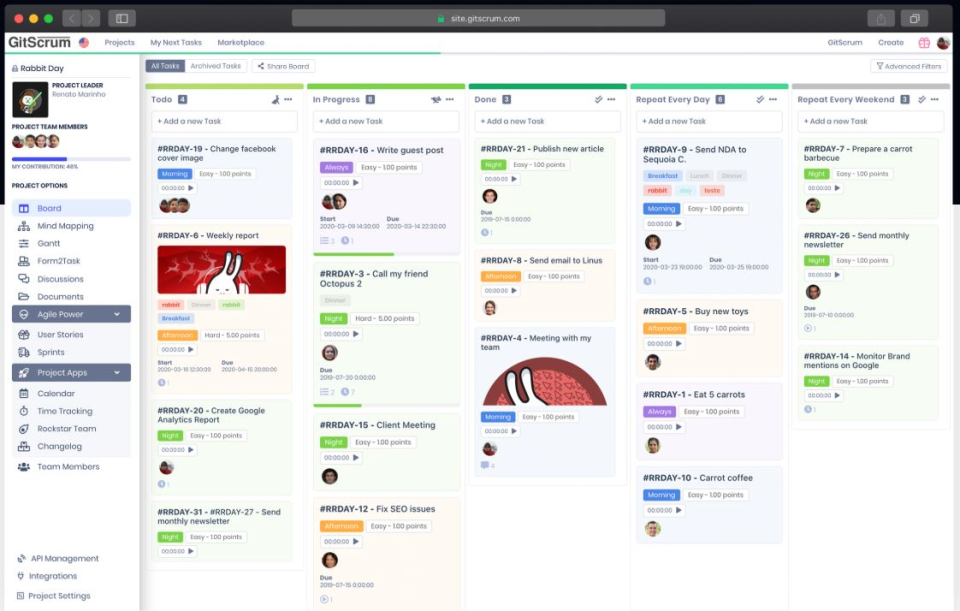
GitScrum is an Agile project management software developed for startups, non-tech teams, and freelancers. It allows users to organize work, manage tasks, user stories and sprints. GitScrum offers personalized boards for team members. You can also share boards with clients if needed. New features, such as mind maps, motivation features, and public forms, keep appearing.
The key features of GitScrum include:
- Scrum support
- Backlog management
- Daily reports
- KPI monitoring
- Sprint planning
- Collaboration board
- Progress tracking
- Roadmapping
- Task management
- Time tracking
Integrations. GitScrum has integration with Zapier, GitHub, Trello, Slack, Google Drive, and Dropbox.
Support. Support is provided online 24/7 by a live rep.
Pricing. You can try GitScrum for free for 7 days. Then you will be offered to continue with one of 4 plans. The plans differ by functionality and the number of users. Pricing starts at $14 per month.
Check out how GitScrum looks like.
Let’s sum up the advantages and disadvantages of the tool.
| Pros | Cons |
|
|
#12. Hansoft
Hansoft is an Agile project management software for team collaboration and management that suits both Agile and traditional development approaches. Hansoft provides quite powerful functionality for both small and large teams. Though the UI is convenient and intuitive, users will have to spend time learning the new platform as it is still rather complex.
Hansoft allows mixing Scrum, Kanban, and Gantt charts. Kanban boards are very customizable, and you can view several of them at a time. This is very convenient for orchestrating the work of different teams. Hansoft also allows for scaling and implementing SAFe and LeSS.
The key features of Hansoft include:
- Cost-to-completion tracking
- Gantt charts
- Kanban board
- Portfolio management
- Time and expense tracking
- Collaboration tools
- Idea management
- Milestone tracking
- Resource management
- Traditional and Agile methodologies
- Dashboards
Integration. Hansoft is integrated with Jira, HelixALM, and HelixCore.
Pricing. There is a free version for five members. Pricing for the full functionality is provided on request.
Support. Perforce offers two support plans priced differently. In all, support is provided online during business hours. The 24*7 Critical Care Plan also implies round-the-clock rapid responses.
Explore how Hansoft works with this video guide.
Let’s sum up the pros and cons.
| Pros | Cons |
|
|
#13. Kanbanchi for G Suite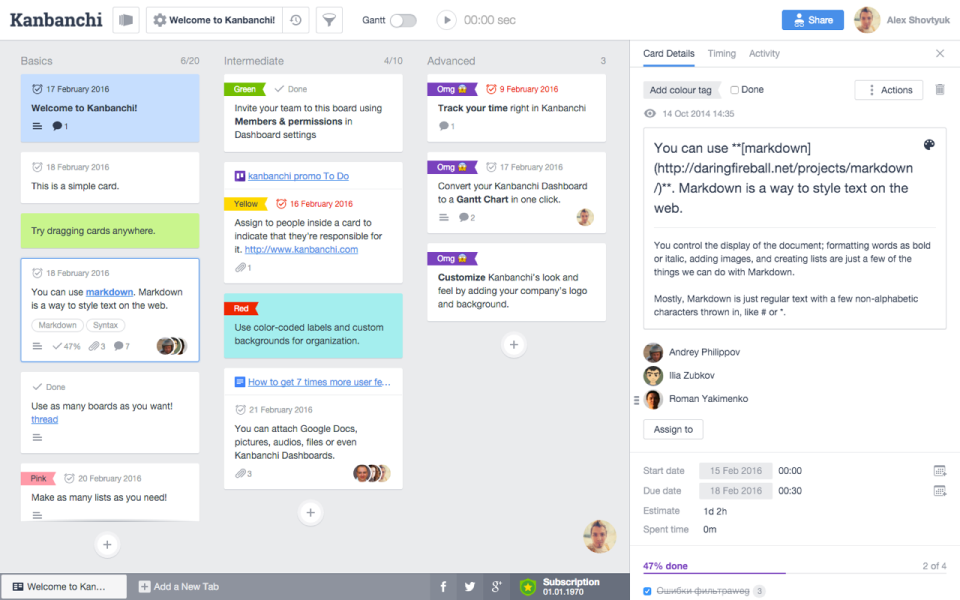
Kanbanchi for G Suite is an Agile project management software that includes Kanban boards, Gantt charts, and a time tracker. The toolkit allows users to visualize their project activity, make workflows more effective, and plan activities easily. It helps to organize team collaboration and provides team performance reports.
For seamless integration with Google tools, Kanbanchi deserves particular attention. However, the lack of a mobile app makes the software less popular with project managers than its alternatives.
The key features of Kanbanchi include:
- Agile and traditional methodologies
- Gantt charts
- Kanban board
- Time and expense tracking
- Collaboration tools
- Customizable templates
- Idea management
- Milestone tracking
- Resource management
- KPI monitoring
- Prioritization
- Dependency tracking
- Roadmapping
- Task management
Integrations. Kanbanchi integrates well with Google G Suite.
Support. Support is provided online during business hours.
Pricing. The pricing for Kanbanchi starts at $9.95 per user per month. The free version is available for 14 days.
This is how Kanbanchi works.
The tool has its pros and cons.
| Pros | Cons |
|
|
#14. GoodDay
GoodDay is Agile project management software with quite strong functionality, a pleasant UI, and a reasonable price. A limited free version can suit small teams with basic requirements. Advanced users of paid licenses can access multiple tools for planning work, organizing tasks on boards, and managing progress, as well as scheduling and prioritizing work, tracking time, managing workload and delivery dates. The tool can be customized to fit your workflows, statuses, project and task types.
The key features of GoodDay include:
- Agile and traditional methodologies
- Cost-to-completion tracking
- Gantt charts
- Kanban boards
- Time and expense tracking
- Collaboration tools
- Idea management
- Milestone tracking
- Resource management
- Backlog management
- Workflow management
- Prioritization
- Scrum support
- Roadmapping
- Dependency tracking
- KPI monitoring
- Reporting and progress tracking
Support. GoodDay provides 24/7 online support with a live rep or basic online support within business hours depending on the pricing plan.
Integration. The free plan implies integration with G-Suite, Google calendar, G-Mail, Google Drive, and Email. More advanced plans also include integration with Slack, Dropbox, and Box. Only the Enterprise users can access the API for other integrations.
Pricing. The software has a free limited version for up to 15 users. The pricing for licenses starts at $6 per user per month.
Have a look at GoodDay.
There are pros and cons of using GoodDay as a PM tool.
| Pros | Cons |
|
|
#15. Axosoft
Axosoft is one more of the Agile project management tools focused on Scrum. It provides a range of features for project planning, as well as Agile bug and incident tracking. It lets development teams manage product backlogs, plan releases, and analyze results. Axosoft is available as an on-premise and SaaS solution. The software allows customization of workflows, fields, templates and roles to suit specific processes of a company. Axosoft lets users create a branded self-service portal for communication with customers and stakeholders.
The key features of Axosoft include:
- Agile and traditional methodologies
- Gantt charts
- Kanban board
- Time and expense tracking
- Collaboration tools
- Milestone tracking
- Prioritization
- Team management
- Workflow management
- Request management
- Scrum support
- KPI monitoring
- Sprint planning
- Reporting
- Roadmapping
- Progress tracking
Pricing. The free trial version includes all features and is available for 14 days. The pricing for paid licenses starts at $126 per month for 5 users.
Support. Customer support works online within business hours. In addition, there is a support portal with a lot of guides. For customers interested in round-the-clock support over the phone and email, Axosoft offers a Premium Support plan at extra cost.
Integration. The tool integrates with Slack, Bitbucket, Toggl, Zendesk, GitLab, and GitHub, as well as provides an API for connecting to other third-party services.
This is how Axosoft looks like.
Now, let’s explore the pros and cons.
| Pros | Cons |
|
|
Summary of 15 best Agile tools
Let’s have one more look at the 15 apps from our Agile tools comparison. We gathered the info about license costs and compared the capabilities of the free versions.
| Tool | Free features | Price |
| Hygger |
|
|
| ScrumDo |
|
|
| PivotalTracker |
|
|
| Jira |
|
|
| Azure Boards |
|
|
| iceScrum |
|
|
| SprintGround |
|
|
| VivifyScrum |
|
|
| Taiga Agile |
|
|
| Sprintly |
|
|
| GitScrum |
|
|
| Hansoft |
|
|
| Kanbanchi |
|
|
| GoodDay |
|
|
| Axosoft |
|
|
Conclusion
There are many Agile project management tools, some are better, some are worse than others. The key is to find the software ideal for your particular company, team, and processes. Every team is unique, has its own workflows, and needs specific integrations.
Explore the 15 Agile development tools listed above and try their free versions to understand how convenient the UI is for your team, how strong the functionality is, how well it suits your processes and requirements. Some of the tools have multi-member fully-featured free versions that will let you check the capabilities in almost real-life conditions.
If you know what to add to this comparison, feel free to share ideas in the comments.





